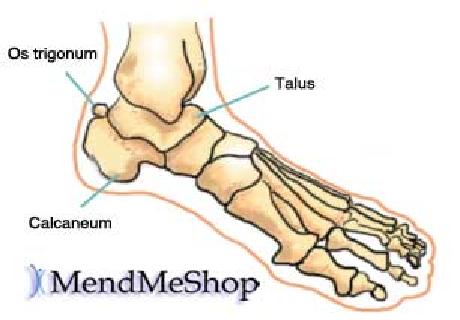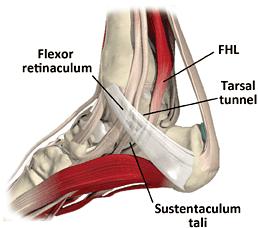There is a bone at the back side of the ankle joint that normally goes into the rest of the boses but can either remain separate or break off. Either way, repeated or traumatic toe down (Plantar flexion) positioning can cause pain in back of ankle. It can either be treated conservatively, with injection, or by surgical removal. A recent article entreats rheumatologists not to forget about this treatable disease.
Rev Bras Reumatol. 2011 Jun;51(3):286-288.
Posterior ankle impingement syndrome: a diagnosis rheumatologists should not forget. Two case reports.
Chiereghin A, Martins MR, Gomes CM, Rosa RF, Loduca SM, Chahade WH. abstract here full article free
- Condition causes a boney impingment in the back of ankle joint aggravated by this extra bone
- This extra bone centre occurs in 5%-15% of “normal” feet
- Toe down position could cause rubbing or trauma there
- Susceptible:
– kicking sports,
– ballet dancers,
– running downhill,
– drivers,
– seamstresses - passive maximum plantar flexion painful as is pressure on the back of the ankle joint
- Plan xrays are often enough – demonstrating the extra bone
- Conservative treatment – rest, ice, physiotherapy, and NSAID anti-inflammatories for 3-6 weeks works 60% of time; not sure what physio could do – maybe someone could explain…
- Injection has been used :
HSS J. 2010 February; 6(1): 99–101.
Posterior Ankle Impingement: Clarification and Confirmation of the Pathoanatomy
Carolyn M. Sofka, free article here
- Surgical removal works 75% of time with return to sports in 3-5 months; Done arthorscopically, has less complication rate, and a return to sports in 9 weeks
Comment – Steroid injection is so successful, I have usually done that first. However, in an athlete, I suspect one is more likely to look at excision. They mention that flexor hallucis longus (FHL) tendonitis can confuse the issue and one article went to great length to inject local into os trignum, avoiding FHL tendon, under ultrasound control, in order to confirm that it is the problem. (same ref as above).
I got the FHL picture from (looks like a good read)
http://www.massagetoday.com/mpacms/mt/article.php?id=14152
They have an article:
Massage Today January, 2010, Vol. 10, Issue 01
Flexor Hallucis Longus Dysfunction
Whitney Lowe, LMT
It mentions how the Flexor Hallicus Longus is “easier to palpate around the medial malleolus near the tarsal tunnel. It is the most posterior of the three tendons that curve around the medial malleolus. When palpating in an anterior direction from the Achilles tendon on the medial side of the heel, it is the first tendon encountered (pic above). The tendon also becomes more prominent to palpation during resisted toe flexion.”
I could see how it could be a differential diagnosis – the presence of a popping sound at the site of the stenosing tendon sheath and the nodule formed by the stenosis would be a tip-off…
addendum – a recent article describes “soft tissue” impingments:
Foot Ankle Int. 2013 Mar;34(3):459-65.
Posterior ankle impingement.
|Giannini S, Buda R, Mosca M, Parma A, Di Caprio F. abstract here
- Posteromedial soft tissue impingement generally arises from an inversion injury, with compression of the posterior tibiotalar ligament between the medial malleolus and talus.
- Posterolateral soft tissue impingement is caused by an accessory ligament, the posterior intermalleolar ligament, which spans the posterior ankle between the posterior tibiofibular and posterior talofibular ligaments.
- Finally, anomalous muscles have also been described as a cause of posterior impingement
Any comments?


